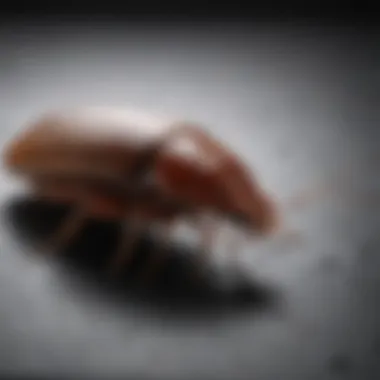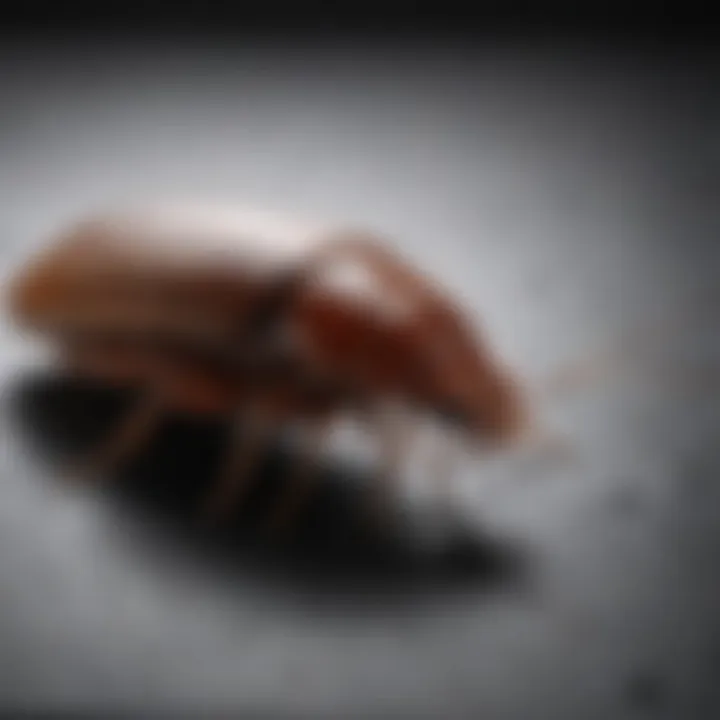Managing Roach Infestations in Used Refrigerators


Intro
Dealing with a used refrigerator that has a roach problem can be a real headache for any homeowner. The sight of those pesky critters scurrying away can send anyone into a frenzy, and rightly so; they are not just annoying, they can also carry diseases. This article aims to provide homeowners and housewives with a comprehensive guide on how to manage these unwanted guests in their fridges. Understanding the pest, employing effective prevention strategies, and knowing control methods are crucial steps in maintaining a clean and safe home environment.
Understanding the Pest
When it comes to battling a cockroach infestation in a refrigerator, the first step is understanding the enemy. Knowing how to identify them and understanding their life cycle can greatly influence your eradication efforts.
Identification
Cockroaches come in different shapes and sizes, but most people encounter the American and German varieties. American cockroaches are typically reddish-brown with a yellowish figure-eight pattern behind their heads. On the other hand, Germans are smaller, light brown, and have two dark stripes on their backs.
To accurately identify whether you have cockroaches in your refrigerator, look for signs such as:
- Small dark droppings that resemble black pepper.
- Shed skins that they leave behind as they grow.
- A musty odor pervading the appliance.
Life Cycle
Understanding their life cycle is essential for effective management. Cockroaches can reproduce quickly; a single female can lay hundreds of eggs in her lifetime. The stages include:
- Egg Stage: Females carry egg cases, usually containing up to 40 eggs, and hide them in dark crevices.
- Nymph Stage: Upon hatching, young roaches emerge as nymphs, resembling tiny adults but without wings.
- Adult Stage: It takes about 2-4 months for nymphs to mature into adults, where they can reproduce and perpetuate the cycle.
Pest Prevention Strategies
After learning who you’re dealing with, it’s time to focus on prevention. Preventing an infestation from occurring in the first place is half the battle won.
Environment Modification
Creating an environment that makes it challenging for roaches to flourish is key. Consider the following:
- Regular Cleaning: Keep your refrigerator and the surrounding areas clean. Crumbs and spills are an open invitation.
- Seal Cracks and Gaps: Roaches can slip through small openings. Use caulk to seal any gaps in and around the fridge.
Physical Barriers
While cleaning and sealing can go a long way, adding some physical barriers can enhance your defense:
- Sticky Traps: Place traps around the fridge to catch any wandering roaches before they settle in.
- Boric Acid Stations: Small containers of boric acid can deter roaches. However, this should be used with care if pets or children are around.
Control Methods
Even with the best prevention practices, sometimes an infestation can occur. Having effective control methods at your disposal is imperative.
Chemical Control
If roaches become too cozy in your refrigerator, chemical control may be necessary:
- Insecticide Sprays: Look for sprays specifically designed for use around food areas. Always follow the instructions carefully.
- Gel Baits: These can be strategically placed inside the fridge and are often very effective as roaches are drawn to them.
Biological Control
Another option is biological control, which is growing in popularity as an eco-friendlier approach:
- Entomopathogenic Nematodes: These are microscopic worms that can invade a roach’s body and kill it within weeks, offering a natural solution.
- Beneficial Insects: Introducing certain types of parasitic wasps, which naturally prey on cockroaches, can help manage populations over time.
"Prevention is better than cure." Keeping your refrigerator clean and free of food slums might save you a lot of trouble down the line.
Ending
Preamble to Roach Infestations in Refrigerators
The topic of roach infestations in refrigerators is not merely a concern for homeowners; it’s an issue that can affect health, hygiene, and overall quality of life. Cockroaches, tiny creatures, can cause significant disruptions when they decide to make a refrigerator their home. While many might consider this just an annoyance, the implications reach far deeper than the surface.
Understanding how roaches invade refrigeration units is essential for any homeowner looking to maintain a clean and safe living environment. Each refrigerator serves not only as a food storage appliance, but as a crucial component in our day-to-day lives, helping us keep perishables fresh and safe from spoilage. When roaches infiltrate this space, they can make food unsafe, leading to larger health risks.


"A clean home is a happy home, but a roach-infested fridge can turn joy into worry."
In this section, we’ll delve into specific elements that make refrigerators attractive to these pests, the various species involved, and the vital responsibility homeowners hold to prevent infestations. Cleaning out a used refrigerator should not be seen solely as a cleaning endeavor but a necessary health measure. Emphasizing the gravity of these infestations is critical; the issue deserves careful consideration rather than dismissiveness.
Understanding Common Roach Species
When talking about roach infestations, the first step is educating oneself about the key species that tend to invade refrigerators. Among the most common culprits are the German cockroach and the American cockroach, each with their distinct preferences and behaviors.
- German Cockroach: Known for their small size and quick breeding, these roaches thrive in warm, humid conditions, making them frequent uninvited guests in kitchen appliances.
- American Cockroach: Larger and more robust, these roaches prefer areas where food is abundant, and may lurk near discarded food remnants, posing a higher risk in used fridges.
Recognition of these roaches and understanding their habits is crucial for managing infestations effectively. Homeowners can strategize their cleaning and preventative measures to target the specific types they might encounter.
Why Refrigerators Attract Roaches
Refrigerators can become a roach's haven for several reasons. First and foremost, food and moisture are the two main offerings that draw these pests in. Broken seals, spills, and forgotten leftovers create an ideal habitat.
Here are some reasons refrigerators attract roaches:
- Food Residues: Even the tiniest crumbs can allure roaches, beckoning them to search for their next meal.
- Warmth and Shelter: The engine compartment or the warm interior of the fridge provides an inviting climate, especially during colder months.
- Moisture: Water leaks and condensation build-up also contribute to a roach's presence, as these insects are highly dependent on moisture for survival.
Awareness of these factors farms a critical baseline for preventing further infestations. Homeowners should not only focus on removing these attractants based on understanding but also stay one step ahead of potential invasions.
Health Risks Associated with Roach Infestations
Understanding the health risks linked to roach infestations is crucial, especially when the pests invade a commonly used appliance like a refrigerator. Roaches are not just unpleasant to see; they can bring a myriad of health issues that may affect everyone in the household, particularly vulnerable individuals like children and the elderly. Their presence magnifies the importance of immediate action and thorough cleaning processes, as these bugs can quickly turn a kitchen from a haven into a health risk zone.
Roaches can spread bacteria and allergens that contribute to significant health problems, making this issue one that cannot be overlooked. For many households, the risk of allergies and asthma exacerbation, alongside food contamination from these pests, poses a real threat to the wellbeing of the family.
Allergy and Asthma Triggers
The droppings, saliva, and even the decomposed bodies of roaches can be potent allergens. When disturbed, these allergens can be released into the air, and inhaling them can lead to respiratory issues. According to the Asthma and Allergy Foundation, approximately 20% of asthmatics report an increase in symptoms related to cockroach exposure.
Even if you've got a clean home, the allergens brought in by these pests can linger long after they've been eradicated. This means that not only do you need to worry about cleaning the fridge itself, but also the entire surrounding area to remove potential triggers.
- Common symptoms include:
- Coughing
- Wheezing
- Shortness of breath
- Nasal congestion
It's paramount to consider these factors seriously. For households with asthma sufferers or those prone to allergies, ensuring that regulations surrounding air quality and cleanliness are strictly maintained is vital.
"The health impacts of roach infestations often extend beyond immediate physical symptoms, leading to long-term health risks that deserve serious attention."
Food Contamination Concerns
Roaches are notorious for carrying various bacteria that can contaminate food. They are attracted to the refrigerator not just for the snacks inside but also for the warmth and the moisture environment it provides. When roaches invade a fridge, the risk of cross-contamination skyrockets.
- Bacteria and pathogens commonly associated with roaches include:
- Salmonella
- E.coli
- Streptococcus
These bacteria can lead to gastrointestinal issues and cause major disruptions to day-to-day life. While it may seem tempting to simply wipe off the outside of a contaminated item, it's important to remember that the bacteria can easily spread to other clean foods through contact. This is why thorough food inspection and proper cleaning methods must be employed immediately once an infestation is suspected or confirmed.
Just keeping the fridge door closed won’t safeguard you against food contamination. Proper cleaning techniques, getting rid of infested foods, and establishing a regular inspection routine can help to spot these issues early rather than late, potentially saving you health risks and costly replacements down the road.
Assessing the Infestation Severity
Understanding the severity of a roach infestation in your refrigerator is crucial for tackling the problem effectively. When you first spot a cockroach crawling in or around your fridge, it can be easy to overlook or dismiss as a one-off incident. However, that small sighting could be the tip of the iceberg. Recognizing the signs and evaluating the extent of the problem allows for a tailored response to eradicate the critters and address any related concerns.
Moreover, assessing infestation severity enables you to make informed decisions regarding cleanup methods, pest control options, and additional preventative measures. It also helps you gauge whether a DIY approach is sufficient or if you need to call in the professionals.
Identifying Signs of Infestation
Recognizing the telltale signs of a roach infestation is pivotal in dealing with the problem promptly. Here are some common indicators:


- Cockroach Droppings: Look for droppings that resemble pepper or coffee grounds. These are often found around the refrigerator motor or within the food compartments.
- Egg Cases: Roaches produce capsule-shaped egg casings called oothecae. If found, immediate action is needed since these can contain numerous new roaches.
- Unpleasant Odors: A musty or oily scent in your kitchen can indicate a roach presence. Their secretions may cause lingering unpleasant smells.
- Visual Sightings: If you catch a glimpse of a roach scurrying away, this is a clear sign of higher numbers.
Identifying these signs not only confirms the infestation but also helps establish your approach to resolution.
Evaluating the Extent of the Problem
Once you have identified the signs of an infestation, it is essential to evaluate how extensive the problem is. This involves determining the following:
- Location: Are roaches confined to just the refrigerator, or are they finding cozy hideouts elsewhere in your kitchen? This helps in establishing the scope of your cleaning efforts.
- Population Size: If you notice several roaches or signs all within the same area, it indicates a larger issue. Conversely, if sightings are rare, it could mean the infestation is still in its infancy.
- Source of Attractiveness: Consider what might be attracting them. Is it leftover food, moisture, or a warm spot? Understanding their motivations can inform your prevention strategies going forward.
'An effective pest management strategy begins with an accurate assessment of the infestation. Ignoring early signs could lead to a more challenging and costly eradication process.'
By rigorously assessing these factors, you can develop a tailored approach that addresses both the immediate problem and lays a foundation for long-lasting prevention.
Step-by-Step Guide to Removing Roaches
Dealing with a roach infestation in your refrigerator can be rather daunting. However, having a clear plan can make the task far more manageable. The importance of a systematic approach cannot be overstated. It not only helps ensure that you effectively remove the pests but also reduces the chances of them returning in the future. A step-by-step guide will provide clarity and direction, making sure nothing gets overlooked in the process.
Preparing the Refrigerator for Cleaning
Before diving into cleaning, it’s wise to empty the refrigerator. Take out all food items, including perishables and condiments. This way, you will not only get rid of the roaches but also prevent the further contamination of your food supply. Once everything is out, it’s important to assess the inside. Inspect every nook and cranny for signs of roaches, including droppings, egg casings, and even live roaches. Clean the shelves and drawers with soap and warm water to start knocking down any residue that might attract these unwanted guests.
Tips:
- Make a list of food items to throw away or clean, ensuring no contaminated product makes it back.
- Remove any cardboard or items that could provide hiding spots.
- Wear gloves and a mask while cleaning for safety considerations.
Effective Cleaning Techniques
Once the refrigerator is empty and you have a clearer picture of the situation inside, your cleaning strategies should involve both thorough scrubbing and possible disinfection. A mixture of vinegar and water works well as a natural cleaner that’s tough on bacteria. Spray it on surfaces and let it soak for a few minutes before wiping it clean. This can help eliminate any odors and might deter roaches.
Additionally, focus on areas where food is stored. Food spills, crumbs, or even sticky residues can act like a beacon for roaches, encouraging them to settle in. Here’s an effective cleaning routine:
- Remove detachable shelves and wash separately with hot, soapy water.
- Wipe down all surfaces with your cleaner of choice and follow with a towel to dry.
- Pay extra attention to the seals around the refrigerator door, as food crumbs often gather there.
With these cleaning techniques, you’re not just erasing traces of the roaches, but also sending a signal that’s likely to keep them away after your hard work.
Utilizing Pest Control Products
After cleaning thoroughly, it may be wise to utilize some form of pest control products. There are numerous types to choose from - some are chemical while others lean more towards natural remedies. If you're concerned about the safety of using chemicals where food is involved, consider opting for a bait or gel formulation instead of a spray.
- Boric acid is a well-known solution – it’s effective, but you must be careful with how it’s applied to avoid any harm to pets or children.
- Diatomaceous earth can also be an effective barrier, acting like microscopic shards that can harm the exoskeleton of roaches, without any toxicity to humans or animals.
- For a greener option, essential oils like peppermint can be mixed with water and used as a spray, acting as both a deterrent and a pleasant scent.
Remember, the aim here is to target the roaches directly while minimizing risks to your health. Before applying any product, it’s wise to read the instructions and ensure that it’s appropriate for use in food storage areas.
"It’s easier to prevent an infestation than to deal with one; keep your surroundings clean to stay ahead of the game."
By following this step-by-step guide, you can transform your refrigerator into a less hospitable environment for roaches. Each stage builds upon the last, ensuring that your efforts are both effective and enduring.
Preventing Future Infestations
Preventing roach infestations in any home appliance, particularly in used refrigerators, is a priority that must not be overlooked. These pesky critters, once established, can impact health and hygiene if left unchecked. Exterminating them is only half the battle; proactive measures are crucial to ensure your refrigerator remains a clean sanctuary for food storage. By preventing future infestations, one can save time, money, and energy, ultimately maintaining a healthier living space.
Regular Maintenance and Inspections
Carrying out regular maintenance is essential for the upkeep of your refrigerator and is a key factor in preventing roach infestations. Inspecting the appliance frequently can help you catch signs of roaches before they become a larger issue. Each month, make it a habit to clean the coils and inside compartments of the fridge. This not only keeps it running efficiently but also ensures that crumbs and residue are eliminated, minimizing food sources for roaches.
In addition to your cleaning routine, perform a thorough inspection for cracks or small gaps where roaches might enter. This includes checking the door seals and any visible joints. An undetected entry point could open the floodgates for a new invasion. Regularly checking both the interior and exterior not only promotes hygiene but serves as a strong line of defense against unwanted roach populations.
Proper Food Storage Practices
Another significant factor in preventing roach infestations is how food is stored in your refrigerator. Roaches are scavengers, and they are always on the hunt for a free meal. Using airtight containers for leftover foods is a must. Glass jars or plastic bins with secure lids are excellent options. Avoid leaving food uncovered or exposed in the fridge.
It’s also wise to dispose of expired items any time you perform a deep clean. Check labels and dates regularly, tossing anything that’s past its prime. In addition, keep an eye on bulk items like rice or flour, and store those in sealed containers as well. This way, you thwart their appetite before they even have a chance to feast.


"An ounce of prevention is worth a pound of cure."
Addressing Environmental Factors
Environmental factors play a significant role in pest control. An often-forgotten element is the surrounding areas near the refrigerator. If your appliance is situated in a damp or dark corner of the kitchen, you're more likely to attract roaches. If possible, ensure good lighting and ventilation in your kitchen space. Dark and moist environments make for ideal breeding grounds for pests.
It’s also advisable to keep the kitchen space neat. Clutter and debris can be havens for roaches to hide, so keep the kitchen clear and tidy. Regularly clean under the refrigerator and behind it as well. Roaches love to hide in warm spaces. By ensuring these areas stay clean, you're cutting off potential habitats they could use as a base to launch their next invasion.
In summary, implementing these preventive measures can significantly reduce the risk of future infestations. Regular maintenance, proper food storage, and addressing environmental factors are fundamental steps to ensuring a cockroach-free kitchen environment.
Eco-Friendly Pest Control Alternatives
When tackling a cockroach infestation, the choice of pest control methods can make all the difference. With rising awareness about environmental protection, eco-friendly pest control alternatives gain more importance. These approaches not only address the immediate problem of pesky roaches but do so with minimal impact on the environment and household health, something that resonates with many homeowners.
Using non-toxic and natural methods reflects a responsible choice. Traditional pesticides may contain harsh chemicals that pose risks to not only roaches but also pets and children. Therefore, exploring eco-friendly options becomes essential for families looking to manage infestations safely and sustainably.
Natural Repellents and Exclusions
There’s a variety of natural repellents that one can use to keep roaches at bay. Essential oils, for example, are great for this purpose. Oils like peppermint, tea tree, and lavender are known for their potent smell that repels cockroaches. You can create a simple spray by mixing a few drops of these oils with water and a small amount of dish soap. This mixture can be applied in and around areas where roach activity is observed.
Moreover, it’s wise to ensure that your home is sealed against pests. Tiny cracks and crevices can serve as entry points for roaches. You should perform regular inspections, especially around windows and doors, to spot these entryways. Utilizing weather stripping or caulking can effectively close these gaps. Here are a few quick tips to consider:
- Use bay leaves: Placing dried bay leaves in cabinets or drawers could also deter cockroaches due to their scent.
- Diatomaceous earth: Sprinkling food-grade diatomaceous earth in cracks can dehydrate and kill roaches without using harmful chemicals. It’s safe to use around pets.
- Boric acid: While it’s a bit more conventional, using boric acid in a controlled manner can help as it’s a natural mineral.
Non-Toxic Cleaners and Their Effectiveness
Cleaning plays a vital role in pest management. Keeping your refrigerator — and the surrounding area — clean reduces the attractants for roaches. Non-toxic cleaners can be particularly effective, enabling you to maintain an eco-friendly household. Vinegar, baking soda, and lemon juice are ideal ingredients for DIY cleaning solutions.
Using these cleaners regularly can eliminate food particles and residues that might otherwise allure cockroaches. For instance, a mix of equal parts water and vinegar can be used to clean surfaces, effectively cutting through residue and leaving behind a fresh scent.
Additionally, consider using biodegradable cleaners that not only facilitate a cleaner environment but also align with eco-friendly values. Not all cleaners are made equal, so it's essential to choose those marked as non-toxic or biodegradable, ensuring they are safe for the family and pets.
"Adopting eco-friendly pest control methods isn't just about removing pests; it's about protecting what you value most — your family and the environment."
Implementing these eco-friendly strategies can be both effective and conscious of health implications. Less reliance on chemical-heavy treatments translates to a healthier home, while the added layer of care for our environment shouldn’t be overlooked. These alternatives help strike a balance between effective pest management and family safety.
When to Seek Professional Help
Addressing a cockroach infestation, especially in a used refrigerator, isn’t a simple task. While some homeowners might feel they can tackle the problem solo, there are moments when calling the professionals is wise. Knowing when to seek out these experts can save not only time but also your health and property. In this section, we will dive into the specific signs that indicate a severe infestation and how to select the appropriate pest control service.
Indications of a Severe Infestation
While it's normal to spot an occasional roach, their presence in large numbers raises a red flag. Here are some clear signs that the situation has escalated:
- Visible Clusters: If you see multiple roaches scuttling, it’s often a sign of a breeding site nearby. Dark corners and hidden spaces are prime breeding grounds.
- Egg Cases: Finding cockroach egg cases, known as oothecae, signifies that more of these pests are on the way. Each case can hold dozens of eggs, exacerbating the problem.
- Foul Odors: A moldy or oily smell could indicate a significant infestation. The droppings, secretions, and decomposing bodies of roaches emit a strong odor that can be hard to ignore.
- Frequent Activity: If roaches are seen during the day, it typically means that the infestation is large enough to disrupt their nocturnal habits. This is a strong indicator that intervention is necessary.
If you identify these warning signs, it’s best to consult pest control before the problem spirals out of control.
Choosing the Right Pest Control Service
Now that you've acknowledged the signs of a serious infestation, the next step is to find the right pest control service. It can be daunting given the myriad options available, but a few key factors can simplify the process:
- Credentials: Ensure that the service is licensed and insured. This protects you from any liabilities and confirms that they meet industry standards.
- Experience: Look for companies that specialize in pest control for refrigerators and similar environments. They will have the specific knowledge needed for your case.
- Reputation: Read online reviews and testimonials. Websites like reddit.com or local Facebook groups can provide firsthand accounts of other homeowners’ experiences.
- Eco-Friendly Options: If you prefer natural methods, inquire about their eco-friendly pest control options. The less harmful the treatment, the better for your home’s environment.
- Guarantees: A reliable pest control service will often provide guarantees for their work, ensuring follow-up treatments if the issue persists.
Taking these steps can lead to a more effective resolution of the cockroach infestation. In the grand scheme of home maintenance, seeking professional help can make all the difference in restoring your refrigerator into a safe, roach-free space.
Culmination
Summary of Key Points
- Identifying Infestation: Recognizing signs of roach presence early is vital to preventing severe issues.
- Health Risks: Cockroaches can lead to health problems, such as allergies and asthma, especially in children and those sensitive to allergens.
- Effective Removal Strategies: Cleanliness, proper food storage, and eco-friendly pest control techniques serve as effective responses to an infestation.
- Prevention: Regular maintenance and vigilance play an essential role in safeguarding against future infestations. Simple practices can save you a world of trouble.
Encouragement for Ongoing Vigilance
Maintaining a roach-free refrigerator is not a one-time gig; it requires consistent effort. Be proactive by regularly checking for signs of food spills or hidden crumbs and acting promptly. Keeping your refrigerator clean not only helps manage pests but also ensures the longevity of the appliance itself.
"An ounce of prevention is worth a pound of cure." This old saying rings particularly true when dealing with pests in the home. You don’t want to wait until a full-blown infestation occurs; rather, it’s best to stay ahead of the curve. Educating yourself about pest management strategies will keep your refrigerator—and, by extension, your kitchen—clean and safe.
Fostering a roach-free environment doesn’t have to be an uphill battle. With the knowledge and tactics outlined here, you can enjoy peace of mind knowing you’ve taken crucial steps toward protecting your health and well-being.







